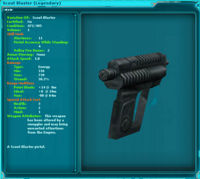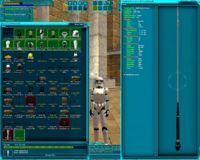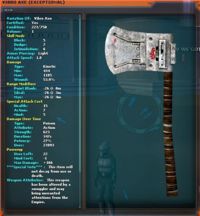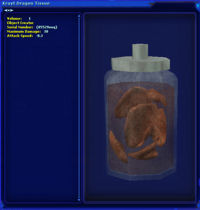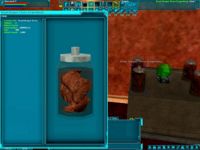Description
For a listing of Attributes and stats available to items see
Item Attributes Listing
|
Related Tags
| 25%
|
This document has been partially completed.
|
|
| Mechanics
|
This document is about game mechanics.
|
|
|
Item Mechanics
Items are the objects in which a player may interact with in the game. Items take various forms from things ranging from being offered as loot, quest rewards, initiating quests, or as usable objects such as foods, buffs, stimpacks and so on. Items take up space within a player's inventory one block at a time per item.
Usable Items have variable properties that may be of benefit or detriment to players. To view these properties, a player must first examine the object and this will bring up an window which will list the properties or stats. Items can be used by clicking on them while in the inventory and waiting for a radial option to appear. Depending on the item, a unique radial option is often given that is specifically for that type of item. Most items may also be used directly by placing them onto the hotbars and using them that way.
The main types of items are as follows:
1. Crafted Items
2. Loot
3. Quest Related Objects
4. Quest Rewards
5. Veteran Rewards
Items have sub mechanics that pertain to the following:
1. Decay
2. Repair
3. Stack Size
Crafted Items & Customization
Crafted items are objects created and distributed by players from the crafting process. Crafted items usually have a number of unique features and stats. Crafted consumable items are usually used by radial menu or by hot baring them. Other crafted items are used as components for other crafts or are decorative in nature. Some items, in particularly pets, come in the form of deeds and upon being used, will deposit the contents into the user's datapad or into the world such as the case with pets, vehicles, and player structures.
There are a number of distinctions between crafted items and items acquired as rewards or loot.
All crafted items come with an identification tag listing the name of the player that crafted the item. This tag is referred simply as the Object Creator. Another feature that distinguishes crafted items from non crafted ones is the use of serial numbers. All crafting related components, schematics and final products are given an 8 digit alphanumeric code upon creation. This makes each item or set of items unique. Looted items do not have serial numbers, with the exception of looted crafting components. In the case of looted crafting components, these inherit the Object Creator attribute but since no player created them, they do not have a name. Looted components are given serial numbers as well so as to prevent making mass production runs of similar components within factories.
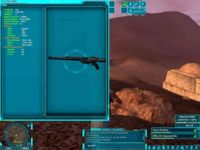 Unnamed Item with Crafted Item Object Creator & Serial Number |
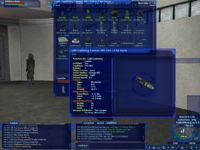 Renamed Crafted Item Object Creator & Serial Number |
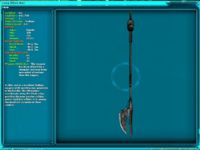 Looted Vibro Axe - No Serial, No Object Creator
|
Item customization is the ability for an item to be changed or modified in some manner. Players have the option to customize some items in the game through the crafting process or by using special features on some items. One way players customize items in the crafting process is giving an object a unique name or designation. Created objects have a default designation given to them such as "Advanced Sword Core." Upon examining the item the player would see the default name within the window. A player customizing this item could change the name to "My Advanced Sword Core." Examining this item would display a some what different image. There is now an attribute added called Variation Of. This indicates that the item being viewed is not the original name of the item but rather it is now classified into being similar to a certain Type of item. Thus, My Advanced Sword Core is a Type of Advanced Sword Core. The type is always from the original object base. During the process of crafting, the name change can occur automatically as the player chooses a particular style for the item during the customization process or by manually renaming the item in the name field. Additionally, an item's name may be transformed once it is placed onto the bazaar or made into a factory crate. For items on the bazaar, the change occurs when items with multiple uses (or quantities) are placed there. This includes individual items or crated items. Any item that potentially has multiple uses will display its current amount (even it is only 1 use left )along with its name while on the bazaar. Viewing these items on the bazaar will then display their Variation Of attribute listing the original item's name without the quantity amount.
Another series of attributes allow to crafted items are the ability to insert attachments into items with sockets. Clothing and armor attachments are used to add skill modifiers to any item to which is created to have sockets. Socketed items are any crafted wearable (clothing and armor) that contains viable sockets. Crafted items may have up to 6 different types of skill modifiers per item up to a maximum of 25 skill per skill modifier.
When it comes to Looted items, this philosophy remains the same. At times certain objects are looted in which have been given special designations such as (exceptional) and (legendary). For example a player loots Advanced Sword Core (Exceptional). These indicate that the object are unique and has special modifiers or enhancements, however they are all still of the same Type of object. Examining this object will indicate the original Base that the item name derives from. These traits are replicated in other base item types as well such as for instance Rancor Tooth components which are their own item type, but of which may also have exceptional, and legendary counterparts.
For more information on exceptional and legendary items, see Loot Components.
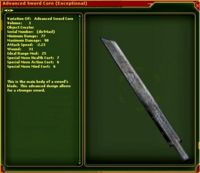 Exceptional Looted Sword Core |
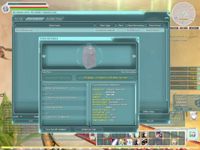 Item with quantity value On Bazaar |
|
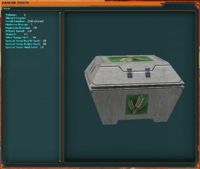 Rancor Tooth - Base Stats |
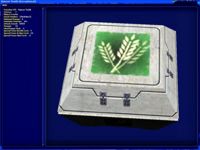 Rancor Tooth - Exceptional |
Another difference between looted and crafted items can be seen in wearable clothing and armors. Looted items do not contain sockets and therefore cannot accept Armor or clothing attachments.
Loot
Loot comprises of a large general class of items that can be acquired by a player. Typically loot is designated as items acquired through the process of retrieval from a mob corpse. Loot may also be extended to include items acquired via rewards or from world containers.
Looted items come in many shapes and forms including decorative pieces, consumables, themed items, along with weapons and armor. Some looted items have the option of becoming Exceptional or even Legendary.
Looted items all have what is referred to as base stats. Base stats represent the unmodified beginning stats an item can have. Items stats have a range in which determines whether the item is marked as base, exceptional or legendary. Stats that go outside of a particular range are moved up into the next higher classification. Exceptional and Legendary Items are special items that the player may run into of which have particular properties or modifiers. An item that is flagged as being exceptional or legendary has properties that go above the base stat range of an item. These items appear in the player's inventory with yellow text to highlight the specialness.
Weapons can show up in the inventory as exceptional or legendary if they obtain additional modifiers such as skill bonuses, DOT (damage over time) effects, enhanced damage, enhanced accuracy modifiers, speed or even reduced ham costs. Weapons are allowed to have 1 DOT effect added to them. This dot can be of any type such as poison, fire, or disease. The DOT effect can be to any random ham pool such as health, action or mind. The only exceptions to this are from night sister lances, donkuwah knives, Nyax Swords, curved nyax swords, and janta knives which have an innate dots, and cannot have another dot of the same type spawned on the item. These items can have 2 dots, but as mentioned the second dot must not be of the same time, i.e no health poison plus health poison 2nd dot allowed.
Exceptional/legendary items may have up to 3 total stat modifiers per item up to a maximum of 25 skill per stat. Item attributes and stat modifiers are selected at random for the item. If any given item attribute is rolled to have exceptional/legendary range, then the entire item is flagged as such. The exception to this are the special Corsec loot weapons which have innate speed mods to them. These weapons can have up to 4 total skill mods.
Legendary items represent the top tier of stats available to a player.
Legendary item stats appear to be based upon a range where the highest point of modification is roughly 10 times the base stats of an item. This means for instance if a Vibro Axe had a min damage of 100 and max of 200 and it was modified by a legendary roll for the maximum amount that the new min would be 1000 damage and the new max would be 2000 damage.
Quest Mission Objects
These are objects given to the player in order to fulfill the requirements of some task or quest that has been given to them. These objects are often things that the player has to interact with and perform some action in order to continue on with the requested task. At other times, these objects are simply things that the player must offer up to an npc or have in their possession in order to proceed to the next task stage. These objects often have a brief description of their general purpose upon examination or usage on the radial.
Quest Rewards
These are objects received when the player completes tasks or missions. Most of the time a player receives rewards from npcs, however other times they obtain rewards from other objects by interacting with them, such as the force shrines offering the player Jedi Robes upon completion of the Jedi Padawan Trials.
Veteran Rewards
See Veteran Rewards for more information
Decay and Condition
Item Condition
Most usable items have a rating for their durability or how long they will last. This is referred to as the item's condition. Item condition can be viewed by clicking on an item in the inventory and using the examine radial option. The condition is presented as a fraction in appearance where the first number represents the current condition and the second represents the current maximum condition. Once an item's current condition reaches 0 it's effectiveness ends and it may not be repaired. When the item reaches this state it is effectively referred to as being destroyed. Destroyed items show up in the inventory as red in coloration signifying that the item may be equipped but that it's properties will no longer work. For example all armor protective properties will be removed (even if the item is equipped). For weapons, the damage will effectively be 1 point. In the case of destroyed Jedi power crystals, the lightsaber will not be equippable at all until replacements are found. If a player is wearing an item that is destroyed, it does not unequip on its own, however it does show up as red in the player's inventory which will allow them to know that it is time to remove the equipment and exchange it for something else if they wish. If the player has a light saber equipped while fighting and the color crystal reaches 0 condition then the damage is reduced to 1 point as with other weapons. New player Starting items, in addition to Clothing, jewelry, and lightsabers, pearls and crystals remain among the few items of which item decay does not remove their inherent properties.
Repair
When repairing an item, the outcome may be one of 4 possible repair types. In order from best to worst:
• The item is repaired with only minor blemishes (MB, 5% max condition decay)
• The item is repaired, but the max condition is reduced (RBR, 20% max condition decay)
• The item is only marginally repaired, and the max condition is reduced (MR, 35% max condition decay)
• The item falls apart in your hands (F, condition goes to 1/1)
Item Decay Formulas
1. Clothing Decay
2. Armor decay
3. Personal Shield Generator Decay
4. Weapon Decay
5. Ship Component Decay
6. Force Crystal and Krayt Dragon Pearl Decay
7. Survey & Crafting Tools
Source References
|





